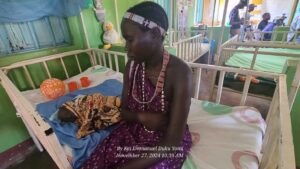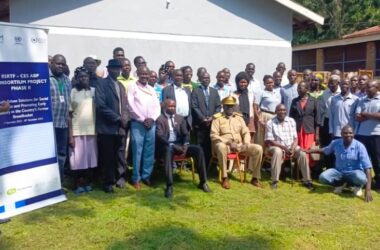By Kei Emmanuel Duku
Residents of South Sudan’s Kapoeta North County, Eastern Equatoria State, a predominantly pastoral area, is facing severe food insecurity, driven by drought and dwindling rainfall.
With crops failing, many are now relying on wild fruits and even animal blood for nourishment.
Farmers in the area report that low rainfall has caused crops to wither and die, while prolonged drought has depleted groundwater levels, negatively impacting livestock and irrigation farming.
However, amidst this difficulty, an introduction of innovative farming techniques such as the half-moon method, a climate-resilient approach, is gaining traction among farmers.
This method introduced by the World Food Program, is particularly effective in restoring degraded land, as it creates semi-circular pits that capture and retain rainwater, enhancing soil moisture and fertility.
In the event of sudden rainfall cessation, the half-moon technique can be complemented by sprinkling or surface irrigation for farmers situated along seasonal rivers.
According to the farmers, this method not only improves soil health but also supports crop growth even during dry spells, ensuring a stable food supply.
Additionally, some farmers have begun shifting to solar-powered irrigation.
Lobai Jonezio Ejula, a 42-year-old member of Naronyit Demonstration Farm in Namonichek Boma, Lakwaamor Payam, shared that farmers in his area are already utilizing the half-moon farming method to retain running water by digging ditches or swales.
“Last year, I lost my entire sorghum crop due to a sudden rain stoppage and subsequent bird infestation but now after joining cooperatives and the introduction of the half-moon farming type, my harvest has increased, now I can’t miss harvest and my children eat regularly,” Jonezio said.
Similarly, Regina Lomoni, another farmer and member of the farm, explained that she joined the cooperative due to ongoing crop failures caused by limited and erratic rainfall.
She recalled that she used to harvest less than five basins of sorghum from her garden; however, after becoming part of the Demonstration Farm, her family’s situation improved significantly.
Lomoni can now harvest more than 100 kg of cereals for both family consumption and sale. Additionally, her daily sales from vegetables range between 20,000 to 40,000 Pounds (approximately $10 to $15).
The farmer attributed her increased sales to the variety of crops and vegetables she grows at the Naronyit Demonstration Farm, as well as the modern farming methods, including irrigation systems, provided to her group by a local non-governmental organization in Kapoeta North County.
“My spouse and I are part of the cooperative, and we invest the income from our sales into livestock. This will ensure that our children have access to milk and improve their health, especially during times of reduced crop harvests,” Lomoni stated.
Aneglo Loyia Aponi, a resident of Napete Boma in Lokwamor Payam, Kapoeta North, said that he turned to cultivating vegetables, cassava, and pigeon peas after losing his cereals to bird infestations and erratic rainfall.
He mentioned that, as a member of a group, he learned various techniques including land preparation, nursery bed setup, and planting drought-resistant varieties such as cassava and cowpeas.
Iracha Gloria, Project Officer for the Norwegian People’s Aid (NPA) in Kapoeta North, stated that through the “Half Moon” project, the organization has successfully transformed over 3 hectares of abandoned land into productive use.This was achieved by establishing demonstration farms.
In the last harvest season, farmers managed to harvest an estimated 700 kilograms of sorghum in what was the first rainy season of its kind, she said.
Gloria mentioned that more than 100 farmers in Kapoeta North have been trained in improved farming techniques, including mulching, cover cropping, crop rotation, and the preparation of organic fertilizers to enhance soil fertility and crop yields.
She further explained that within the 3 hectares of the demonstration farm, 36 half-moons were constructed to combat soil erosion and conserve running water.
“Traditionally, farmers have not mulched their crops after weeding, which leaves the soil exposed to the sun and leads to significant water loss. This practice increases the risk of crop failure during drought periods, eventually resulting in famine in the area,” said Gloria.
Meanwhile, Morris Oteka, an agronomist and supervisor at the Naronyit Demonstration Farm, explained that the farm utilizes shallow wells and tunnels to manage water drainage for irrigation. This system ensures that crops are not affected by unexpected interruptions in rainfall.
“The river is seasonal but does not completely dry up. When farmers dig swales deep underground, they can access water for irrigating their crops,” Oteka noted.
Despite the farm’s successes in reducing hunger, Oteka mentioned that farmers in the area still face challenges such as pest and disease infestations, inadequate seeds, and shortages of other agricultural inputs.
He urged farmers to diversify their crop production and cultivate drought-resistant varieties to minimize losses from pests, birds, and droughts.
Hunger crisis
A new report from the Integrated Food Security Phase Classification (IPC) warns that 6.3 million South Sudanese are expected to face acute food insecurity by the start of 2025, with 1.71 million facing “emergency” levels and 41,000 “catastrophic” levels. Children are often among those hardest hit, with 2.1 million children under five expected to suffer from acute malnutrition.
The report attributes the crisis to various factors, including flooding and dry spells, currency depreciation, and soaring food prices.
Eastern Equatoria State has been one of the areas hit hardest by climate change. 40% of the population in the State are food insecure.
Reports from local health facilities indicate a rise in cases of malnutrition among young children, with families struggling to provide even basic sustenance.
Mary Nasike, 28, has faced the struggle of malnutrition within her family. Two of her four children have previously received treatment. Her 7-month-old baby has been admitted to Riwoto Primary Healthcare Centre, displaying concerning symptoms: underweight, lethargy, and a significant loss of appetite for breastfeeding.
Nasike explains that her family’s primary source of income is farming and livestock rearing. However, their agricultural yield is entirely reliant on unpredictable rainfall patterns.
When harvests are poor, her family is forced to relocate to their cattle kraal. This measure is taken to ensure the children’s survival by relying on cow’s milk, while the adults survive on a meager diet of boiled cow’s blood.
“When milk is unavailable, I boil sorghum and salt for the kids to eat,” said Nasike.
“I stab the cow anywhere on its body, and the blood flows into a saucepan or container, since I can’t afford cooking oil or onions, I simply boil the blood and mix it with butter and we eat it,” she described their situation.
Nasike acknowledges that cow’s blood provides a relatively reliable food source, but with only five cows, it is insufficient to sustain her family consistently.
To supplement their inadequate diet, Nasike ventures into the forest to gather wild fruits, such as African Barlets. After collecting the fruits, she soaks them in water to extract their juice. This juice is then boiled and poured over porridge also made from African Barlets.

Nakia Lotor, a 26-year-old mother of one, reports that her child often falls ill and is losing weight. Upon examination by the Community Nutrition Support staff, it was found that her child was underweight.
Lotor, who got married at 18, noted that her two-and-a-half-year-old child improved significantly after receiving treatment for malaria and being placed on a special diet that included Trisodium Phosphate, a treatment commonly used for malnourished children and pregnant women.
“After interacting with nutrition support staff at the health center, I learned my child was undernourished. This led me to abandon harmful practices like believing in witchcraft. Today, my child is thriving and gained weight of over 2. 89 Kg compared to the previous 1.96Kg,” said Lotor.
Juru Juliet, Save the Children’s Nutrition Coordinator in the Kapoeta North, highlighted inadequate food intake by children, breastfeeding mothers, and pregnant women as a major problem in the area.
She noted that women-headed households are disproportionately affected by food insecurity due to the prevailing gender roles, where men prioritize pastoralism while women are primarily responsible for crop cultivation.
According to the nutrition specialist, malnutrition in Kapoeta North is also influenced by cultural taboos that restrict pregnant and breastfeeding mothers from consuming eggs, silverfish, and other food types despite their high nutritional value.
“Food insecurity peaks between March and June as households deplete their food stocks before the harvest. This scarcity often leads to malnutrition, with over 40 children and 50 mothers admitted monthly,” said Juliet.

Juliet stressed the need for greater community awareness of hygiene, exclusive breastfeeding for infants, and the value of kitchen gardens that allow families to grow vegetables and achieve a more balanced diet.
Supplementary feeding programs that help children and mothers at risk of malnutrition are also crucial.



